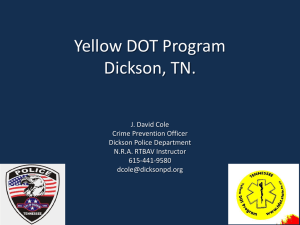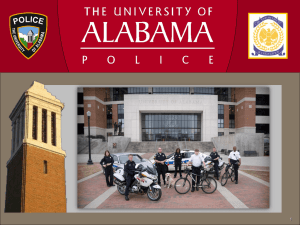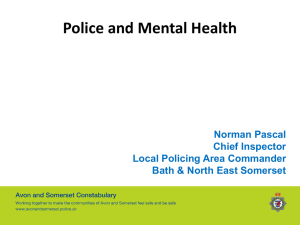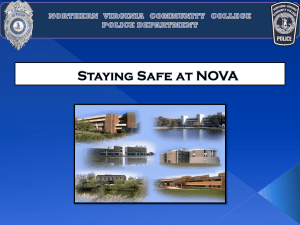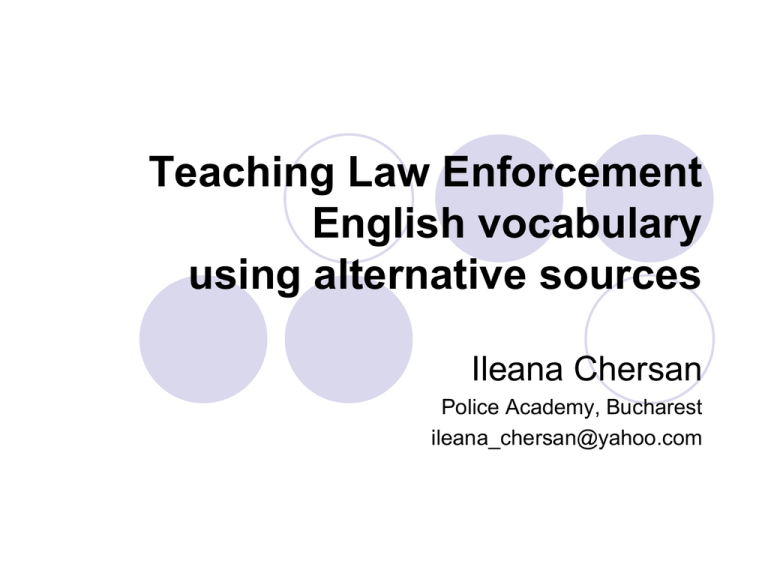
Teaching Law Enforcement
English vocabulary
using alternative sources
Ileana Chersan
Police Academy, Bucharest
ileana_chersan@yahoo.com
Hypotheses
A great stylistic diversity is acknowledged in Law Enforcement
English (LEE)
This is reflected in various sources
Learning is conditioned by availability and accessibility of such
resources
Coursebooks do (some of) the job
Non-conventional sources may enrich the learning context
Linguistic and fictional sources set the base for integrated language
learning
Advantages of using coursebooks
Coursebooks
often shape both course syllabus and methodology
use standardized and approved materials to standardize
teaching and learning
maintain quality based on months / years of research,
feedback, revision
foster paced learning and refer to past and future learning
contents
(cf. O’Neill 1982)
Potential advantages
of using coursebooks
Coursebooks may
be specifically designed or at least suitable for
students’ needs
provide a diversity of learning resources
(workbooks, CDs)
be practical (well-presented, inexpensive, visually
appealing)
be adapted to stimulate interaction
be suitable for various teaching and learning styles
Disadvantages of using coursebooks
Coursebooks
may not reflect students’ needs
shouldn’t build the content of a language program
may contain inauthentic language to incorporate
teaching points
may lack variety, flexibility, spontaneity
commercially available coursebooks are expensive
students refuse the statute of “captive learners”
teachers feel deskilled
(cf. Cunningsworth 1995)
Why adapt and supplement coursebooks?
to reflect on the changing needs (learners and
society)
to bring in authentic, unaltered language
to expose learners to real contexts of use
to involve learners in shaping their education
to involve teachers creatively in research and design
The new chart of ESP
(cf. Hutchinson & Waters 1987)
English for
Engineering
Medical
Studies
Hospitals
Economics
Tourism
Law
Teaching
Computer
Finances
Secretariat
Psychology
Military
Aviation
Accounting
Waiters
and
Catering
Radio
Sports
Law
Enforcement
EAP
EOP
EST
EAP
EOP
EBE
ESP
EAP
EOP
ESS
The features of LEE as a specialized lexicon
The most developed and marked trait of a specialized
discourse is the lexicon (cf Bidu, Cabré, 1991; Gotti, 2003)
Characteristics of a specialized lexicon:
- monoreferentiality (ARV, stab vest, autopsy, blotter,
inebriation, petty constable);
- denotative function (MET, interrogate suspects, involuntary
manslaughter);
- referential precision (luminal, tracer, cuffs, truncheon);
- conciseness (breathaliser, MET, PACE, GSR, juvenile).
Lexical strata in LEE
Styles are ” varieties of language viewed from the
point of view of formality" (Trudgill, 1995 : 49).
LEE reflects specific police activities, viewed
according to participants and contexts:
function: practitioners, lay people, the media
social class and educational background
relation with the law and order
Registers and sources of LEE
Writ
ten
docu
ments
Spoken policing
Media
Brief
ings
Inter
views
Radio
patrol
Victims/ Crimin
als’
Inform News
Films Witnes
talk
al talk Docume Series ses
discourse
ntaries
Academic
+
+
-
-
+
-
-
-
Jargon
+
+
+
+
+
+
-
-
Familiar
-
-
-
+
-
+
+
+
Colloquial
-
-
-
+
-
+
-
+
Slang
-
-
-
-
-
+
-
+
Clichés
+
+
+
+
+
+
-
+
Lexical strata in Police English
(cf. Crystal, 1990)
a) Colloquial language to feel someone’s collar (to arrest someone), to be
caught red-handed / on the job, to put someone inside (send to prison),
to cook the books, in cold blood, in hot pursuit, cold turkey (the
unpleasant effects after stopping taking drugs);
b) Standard phrases: the caution “You have the right to remain silent. But it
may harm your defence if you not mention when questioned something
which you later rely on in court. Anything you do say may be given in
evidence”.
c) Jargon: to beat the streets, to conduct a crime scene examination, to do the
fingerprints match, to do a high-risk vehicle stop, to make a positive ID on
somebody, to put an APB on a suspect, to take into custody, to view an
identification parade, codes and acronyms.
d) Slang: Black Maria (police van), pedigree man (repeat offender), dry bath
(skin search), sleeping policeman (speed bump), five-finger discount
(shoplifting), handshake (bribe), to play the piano (to be fingerprinted),
lead poisoning (killing by shooting).
Police officer terms
bobby
bluebottle
bogey
border warren
Bow
Street
Runner
Body-guard
beadle
bull
busy
constable
cop
copper
care-taker
detective
dogberry
dick
flat
foot
/
splayfoot
flattie
flat-footed
flat feet
fuzz
gendarme
guard
grass
/
grasshopper
gumshoe
hawkshaw
jemadar
jack
keeper
knocker-up
police
knickers
policewoman /
lollipop lady
matron
mug
police
mug john
lieutenant
meter maid / Paddy
lady
Portreeve
nark / narc
posse comitatus
patrolman
plainclothesman
peace officer
officer
peeler
old Bill
peon
rozzer
pig
runner
pointsman
shamus
police officer
slop
policeman
sentry
sowar
shoofly
speed cop
sheriff
splay foot
splay-foot
trap
tail
thief taker
trooper
the Sweeney
the force
the rank
warder
warden
watchman
Police talk v. general English talk
Genuine radio communication
‘Translation’ into General English
Dispatcher: Adam Twelve code five.
Adam Twelve: Twelve, code five, go
ahead.
D: I’m showing a warrant on your
party,
Doe, John, date of birth three five of
sixty,
showing physical as male, Caucasian,
six foot, two-eighty,
blond and blue, break—
AT: Go ahead.
D: Out of Birmingham,
failure to appear on domestic
disturbance.
Two juveniles involved.
Thousand pounds bail, break—
AT: Copy. I’m on route.
Dispatcher: To police officer Adam (Nixon):
We have a person with a warrant.
Adam: Adam here. I understand we have a
wanted person. Communicate.
D: I’m sending you the warrant on your person,
John Doe, date of birth 3 May 1960,
described as a white male,
6 feet tall (1.80m), weight 280 pounds (125
kg),
blond hair, blue eyes…
A: Go ahead.
D: He is from Birmingham,
where he didn’t appear in court when charged
with domestic violence.
Two children are involved.
He posted a £1,000 bail…
A: I understand. I’m on my way (to get him).
(from http://www.hodrw.com/cop1.htm)
Non-conventional LEE sources
Linguistic
corpora
- maps
concordances
- timelines
thesauri
- indexes
other dictionaries
Fictional
literature (detective fiction)
films and series
games
Corpora
Corpus = collection of written or spoken utterances
(applications in theoretical linguistics to lexicography,
second lg. acquisition and translation)
Advantages: authentic data, quantification, context,
unbiased
Disadvantages: not representative, not relevant,
incomplete, not reliable
Eg. BNC
British National Corpus
Search: POLICE
A34 6 In Dresden, witnesses reported violent clashes between
police and would-be emigrants desperate to board trains to the
West.
A6V 420 They say that the police could stop the violence
overnight if the Special Patrol Group was assigned to patrol the
area, or if the Home Office made it sufficiently clear that this kind
of activity must stop.
A95 504 Polish protesters hurled paint and petrol on a monument
to Lenin in Krakow and set it on fire yesterday before clashing
with police, who used force to break up the second anti-Soviet
disturbance in a week.
AHN 1198 He is surrounded by police, reporters and
photographers who move with him like bees in a swarm.
BNC – Key word
ABS 2422 They carry pistols, handcuffs, batons and gas-spray guns.
AKR 83 Ever since she brandished a pair of handcuffs during a debate on
law and order at the Conservative Party conference in 1981, Mrs Currie has
demonstrated an irrepressible ability to draw attention to herself.
C85 693 ‘Thompson at your service,’ said the landlord coming to meet him
with a welcoming smile which disappeared quickly as he saw Midnight —
his glance sliding from the metal collar to the handcuffs and on to Jess's
flushed face.
CBF 13277 One of five officers was kicked unconscious and another had
his nose broken after one of the prisoner slipped his handcuffs to lead the
assault.
CEM 2224 And he cannot leave the cell without handcuffs and shackles.
CLD 686 ‘I want to know the identity of a man, I want to reach him, I want to
put him in handcuffs and read him a charge of First Degree murder.’
Concordances
Concordance = a collection of contexts of a
particular key word
eg. AntConc
http://www.antlab.sci.waseda.ac.jp/antconc_index.html
Applications:
Tagging parts of speech
Frequency analysis
Key words in context
Co-occurrence analysis
CRIME concordances
1 is in some way affected by crime. Taxes pay patrolmen, detectives, and
2 for having committed such a crime, not only they suffer but so may their
3 of the police to investigate crime with the purpose of putting the bad guys
4 patient. Patience is a virtue in crime fighting because police officers and
5 has to get away with every crime he or she commits. However, to get
6 detective, this was an easy crime to solve. However, much later in that same
7 witnesses and searching the crime scene for obvious clues as to a criminal’s
8 have many different kinds of crime and criminals to investigate. There is
(from Criminal investigations, Colin Evans, 2009)
Find the missing word…
..the fundamental axiom of crime scene --------------. It drives fingerprints, trace
..by the sloppiness of the original -------------. He found that the accused man
..life cycle of maggots was able to aid the -------------- of the murders of Isabel
..kidnapping reached the Federal Bureau of ------------- New York office.
..handwriting experts, drafted into the --------------- headquarters at Mineola,
..forensic science. During the ------------- an army of experts flooded the By the
..Carolina State Bureau of -------------agent Duane Deaver testifies during by a
..lack of clues, the murder ----------- gradually ran out of steam. On the results
..stunned those leading the ---------------: not only had the porter not killed
Thesauri
e.g. Wordnet
http://wordnet.princeton.edu/
large lexical database of English
nouns, verbs, adjectives and adverbs are grouped into
sets of cognitive synonyms (synsets)
(117000) synsets are interlinked by means of
conceptual-semantic and lexical relations (supersubordinate relations)
WordNet description of ‘police officer’
S: (n) policeman, police officer, officer (a member of a police force) "it
was an accident, officer"
direct hyponym / full hyponym
S: (n) bobby (an informal term for a British policeman)
S: (n) bull, cop, copper, fuzz, pig (uncomplimentary terms for a
policeman)
S: (n) captain, police captain, police chief (a policeman in charge of a
precinct)
S: (n) Chief Constable (the head of the police force in a county (or similar
area))
S: (n) constable, police constable (a police officer of the lowest rank)
S: (n) detective, investigator, tec, police detective (a police officer who
investigates crimes)
S: (n) dick, gumshoe, hawkshaw (someone who is a detective)
S: (n) plainclothesman (a detective who wears civilian clothes on duty)
S: (n) tracer (an investigator who is employed to find missing persons or
missing goods)
S: (n) gendarme (a French policeman)
S: (n) inspector (a high ranking police officer)
(…)
Antonyms
(from www.merriam-webster.com)
derivational antonyms: legal – illegal, lawful – unlawful;
arrestable offence – non-arrestable offence
contradictory antonyms: to press changes – to drop
charges, minor offence – serious offence, on duty – off
duty, arrest by warrant – arrest without warrant
contrastive antonyms: civil law – criminal law, break a law
– observe a law, grant bail – deny bail, lenient law – severe
law, original / genuine document – forged document
Indexes
abduct, (-ee, -ion, -or), 74, 80, 115, 129, 212
abuse, (-ive), 70, 74, 82
accessory, 62, 70, 82
accident (reconstruction), 211
accomplice, 66, 86
accusation, 66, 74
acquit, 66
act, 65, 70, 95, 100, 223
actual bodily harm, 76
actus reus, 77
Adam Tyler, 122
affidavit, 77
affray, 127
AFIS, 207
agent provocateur, 97
aggravated 66, 129
aggressive police response, 102
aim, 219
aka, 75
Police-related compounds, collocations and phrases
(compiled from Oxford Dictionary of Law Enforcement; PACE; www.met.co.uk; OED;
Marin, Baciu, 2008; Harabagiu, 2006)
abusive behaviour
accident record book
accredited person
action plan order
act in self-defence
act of state
actual bodily harm
actus reus
adjourn a sentence
admissibility of
evidence
advance information
adversary procedure
alibi witness
allegations of rape
alleged offence
agent provocateur
age of consent
age of criminal
responsibility
aggravated assault
aggravated burglary
aggravated circumstances
alternative verdict
animal cruelty
appear in court
apply for parole
armed robbery
arm restraints
arrestable offence
arresting officer
arrest offenders
arrest techniques
arrest warrant
assault rifle
assured tenancy
attempted murder
attend a crime scene
audio surveillance
authentic signature
…
Contextual distribution of a key word:
constable
DUTIES
POWERS
SITUATIONS
PEOPLE
pursue villains
issue a statement
be a party to the
appeal
go out on the beat
tell jury
recover bodies
pursue a drive
execute (his duties)
undertake a review
carry out a test
help victims
restrain a man
fine
use powers
order a review
warn (smb.)to stop
sign a certificate
decide on specimen
procedures
grant licence
exercise a statutory
power of arrest
require a specimen of
blood
order an inquiry
propose a course of
action
escape from gunman
chase cars
have lawful justification for
his conduct
witness the obstruction of
justice
give reasons for conducting
a search
reasonably suspect
be obstructed in the
execution of his duty
be discharged from duties /
dismissed
be in the force
know whereabouts
Major
minister
solicitor
witness
policemen
guards
defendant
perpetrator
scene
justice
government
villain
administration
Hyponyms – road safety
Headings
Phrases
Speed surveillance
Automatic speed surveillance
Drunken driving and drugs
Drug abusers in traffic
Consequences of drunken driving
Intoxicants and the right to drive
Use of safety equipment
High-risk drivers
Driving bans
fixed fine
breathaliser
a minimum of 50 mg of alcohol per 100 ml of
blood
impair a driver’s observation skills, coordination,
balance, and reaction speed
banned from driving
issue or renew a driving licence
wear a seat belt
maximum length of a driving ban is six months
previous sanctions
Picture description - riot
Conduct a poll – ranking
Below are some actions the government could take to
control the use of drugs. Rate the effectiveness of each.
Very
Some
wh
at
Don't
Not
Kn
Very
ow
"Stop the illegal importation of drugs from other countries"
"Arrest people who sell illegal drugs in this country"
"Provide drug treatment programs for drug users"
"Educate people about the dangers of using illegal drugs"
"Arrest drug users in this country"
Oxford English Dictionary
1. Mil. a. A small number of men, a subdivision or section
of a company, formed for drill or told off for some special
purpose
4. c. A unit within a police force, organized to investigate or
prevent a particular type of crime; freq. in ellipt. use for
flying squad s.v. FLYING ppl. a. 4e (b). See also fraud,
murder, riot, vice squad at first element.
1905 N.Y. Times 22 June 8/6 Commissioner McAdoo selected yesterday
the men for the special squad which will arrest women in the streets.
1928 E. WALLACE Flying Squad xv. 132 You do your best, eh? You did
your best to put Bradley away, and draw the attention of the Squad to you
and me!
1962 Daily Tel. 15 June 22/5 Three detectives, two of them drug squad
officers, flew to Gibralter from London yesterday to investigate the haul of
illegal drugs found in the cruiser Belfast.
(www.oed.com)
19th century weapon
v. 20th century weapon
19th century WEAPON
edged
blunt
portable non-portable
sword truncheon truncheon
cutlass
revolver
-
lethal non-lethal
standard specific
revolver
nightstick
flintlock pistol
-
-
20th century WEAPON
edged
-
blunt
baton
portable
non-portable lethal
baton
explosives
taser
water cannon
CS spray
pistol
rubber bullets
gas projector
pistol
non-lethal
standard
baton
baton
taser
taser
CS spray
rubber bullets
gas projector
specific
explosives
water cannon
gas projector
Oxford Advanced Learner’s Dictionary
police > appeal, badge, blotter, Interpol, body search,
breathalyzer, (…) arrest > station, guilty, (…) crime
> acquit, arson, aggravated, accomplice, bring
charges (…) alibi > prove, commit (…) evidence >
confirm, dismiss, affidavit, groundless, not proven
(…) caution > warn, officially (…) court > appeal,
adjourn, alimony, etc.
The conceptual field of police powers and duties:
sequences of events (1)
Chains of events: ARREST
identify a suspect > apprehend a suspect >
restrain a suspect > handcuff a suspect >
search a suspect > arrest a suspect > read
the rights > escort a suspect to the police
station > take the suspect into custody >
detain a suspect
The conceptual field of police powers and duties: sequences of
events (2) - Scenarios
Criminal slang words and phrases
(selection form Harabagiu, 2006: 164 – 177, Dictionary of Slang and
Cant, Oxford Dictionary of Slang, www.urbandictionary.com)
crimes
criminals
police officers
crime tools
police divisions
drugs
relationship to the police
rhyming slang
Slang for crimes and offences
beagling = pickpocketing
to cabbage = to steal money
to carve up = to share dishonest gains
to chisel = cheat or swindle
cobbling = forgery of passports
to cop = to take bribe
to cross = to swindle
dancing the stairs = daylight stealing from unattended flats or offices
to do a bust = to break into a flat of a house
to do a cloth job = to break into a church
double shuffle = swindling
to fake the broads = to forge coins
fixit = illegal selling of stolen cars that have been repainted and reregistered
Glossary of common police terms, acronyms,
and jargon
A.K.A
A/O
At Large
Auto Burg
Back up
Bail
Beat
Centerpunch
Chip
Cite Out
Clan Lab
CLETS
Code - 1
Code-33
Cold Paper
Community
Adjustment
Cop the
Plate
Cop
CORI
Crook
Cross
D.L.
D.O.A.
D.O.B.
Dime Bag
Dirty
Dope
Double-deuce
Gatt
DUI or DWI
Gate Out
GOA
Going Down
Hit
Hot Prowl
I.R. Number
ICAM
Lawyer Up
Line-Up
Lt
Miranda
Mug
Nickel
On the Box
PC Dec
Perimeter
Perp
Plastic
PO
Porac
Precursors
Priors
QOA
Rap Sheet
Run Out
Sarge
Search
Clause
Slammer
Snitch
Super Court
T-Bone
Tag
Verbal
Vic
Warrant
Weed
Went Down
Whack
X-Unit
Conceptual divisions (mindmaps)
Description of persons (Police Training Manual, p.276)
Height:
Build:
exact if known, otherwise approximate.
proportionate, stout, corpulent, heavy, thick set, thin, slim,
well built, military bearing, erect, slouches, stoops
Complexion: fresh, ruddy, florid, pale, fair, sallow, blotchy, pimply, uses
cosmetics.
Face:
round, oval, long, wrinkled, flabby, fat, thin, high cheekbones; expression – vacant, scowling, pleasant.
Hair:
colour, turning grey, going bald, wavy, straight, curly,
frizzy, parted, unparted, brushed back, long, short,
greased, unkempt, wears wig, bleached, dyed, sideburns.
Hair on face: beard (shape and colour), moustache (size, shape, colour,
waxed), dark chin, stubble.
Head:
large, small, narrow, square.
Forehead:
high, low, broad, narrow, wrinkled, bulging, receding.
Eyebrows:
colour, thick, thin, bushy, plucked, pencilled, arched, meet
in centre, sparse.
(…)
Students write quizzes for others.
1 Name three types of complexion.
fresh, ruddy, pale,
pimply
2 What is a wart in Romanian?
neg
3 What is the correct order? a) a
casual short leather jacket: b) a
short casual leather jacket; c) a
leather short casual jacket
4 Another name for a criminal’s
photograph.
5 What is an E-fit?
b)
mug shot
a computer-generated
image
Suspect description
Timelines
1901 Fingerprint database
1902 Borstal opens for young
offenders
1903 WPSU founded - the
Suffragettes
1907 Probation Service
1910 Radio used to arrest
Doctor Crippen
1914 Great War begins
1917 Russian Revolution
1926 General Strike
1933 Great Depression
1936 Open Prison - Wakefield
1948 Attendance Centres
1965 Death Penalty ends
1965 Race Relations Act
1971 Crown Courts
1973 IRA Bombing of England
begins
1975 Sex Discrimination Act
1981 Inner-city riots
1982 Borstals abolished
1984 Great Miners' Strike
1985 Heysel Football Disaster
1990 Strangeways Riot
Translations
Lists - Basic Special Police Operations Terminology
Follow up: act out (role play)
1
2
3
4
5
6
7
8
9
10
11
12
13
14
15
16
Romanian
English
Stai, Politia!
Ramai pe loc / Nu misca
Culcat
Fata la perete
In genunchi
Ramai pe loc / acolo
Intoarce-te (cu spatele)
Opreste-te
Mainile la vedere
Mainile pe cap
Intinde mainile
Lasa vorba
Arunca arma
Lasa arma jos
Vino spre mine
Arata-mi mainile
Police, don’t move / freeze
Don’t move / Stand still
(Lie) down!
Face the wall
On your knees
Stay there / where you are
Turn around
Stop
Keep your hands at sight
Hands on the head
Spread your arms
Shut up
Drop your weapon
Put your weapon down slowly
Step forward / Come to me
Show me your hands
Lexical concept comparison - Ranks
Rank
Translated as
Military rank
equivalent
French police
rank
equivalent
British Met
rank equivalent
Chestor-general
de poliţie
Police QuaestorGeneral
General
Inspecteur
général
Commissioner
Chestor-şef de
poliţie
Police ChiefQuaestor
Lieutenant General
Inspecteur
général
Assistant
Commissioner
Chestor de
poliţie
Police Quaestor
Brigadier General
Contrôleur
général
Commander
Comisar-şef de
poliţie
Police ChiefCommissioner
Colonel
Commissaire
divisionnair
e
Chief Superintendent
Comisar de
poliţie
Police
Commissioner
Lieutenant Colonel
Commissaire de
police
Superintendent
Subcomisar de
poliţie
Police SubCommissioner
Major
Commissaire de
police
Superintendent
Inspector
principal
Police Principal
Inspector
Captain
Commandant
Chief Inspector
Inspector de
poliţie
Police Inspector
Lieutenant
Capitaine
Inspector
Subinspector de
poliţie
Police SubInspector
Second Lieutenant
Lieutenant
Inspector
Translate public information
ACVILA Groups
- Combat group
- Sniper team
- Protection team
They carry out training activities as follows:
* Physical training
* Psychological training
* Climbing and rope descending
* Parachuting
* Diving
* Pyrotechnics. Controlled explosive devices
* Aggressive car driving
* Intervention techniques and tactics
* Instinctive shooting techniques and tactics
* VIP protection
* First aid
Interactive games
(http://crimeandinvestigation.co.uk/shows/games/)
Go to: Crime scene, Interrogation room, Research library,
Evidence lab, Autopsy room, Investigation board
LEE in the media
A Bruises on her neck provided some evidence of the liberties that her
assailant(s) took with her, with her windpipe perhaps crushed while she may
have helplessly looked into the face of her murderer through the layers of
clear packing tape across her face, this as her killer choked the last breath
out of her.[The Guardian]
B Local Community Information - Robbery Alert
Be vigilant, watch out for unsolicited approaches
from people you do not know.
Be careful when engaging with strangers
who whish to hug or dance with you.
Please help us by keeping your mobile phone
and other valuables safe.
If you need emergency police
assistance, call 999.
http://www.flickr.com/photos/doctorow/3621698242/
LEE in crime fiction
Detective fiction
The whodunit: complex, plot-driven story in which the reader is provided
with clues.
Locked room mystery: the crime is committed under apparently
impossible circumstances
Cozy: sex, profanity or violence are downplayed or treated humorously.
Later and contemporary contributions to the whodunit
The historical whodunnit
The inverted detective story
The American hard-boiled school
The police procedural
The legal thriller
The spy novel
Caper stories and the criminal novel
The psychological suspense:
Spoofs and parodies
“Every thief .....cowers before him, like a schoolboy before his
schoolmaster. All watch him.... all seek to propitiate him.... but, let
Inspector Field have a mind to pick out one thief .... ,.... let him
produce that ghostly truncheon from his pocket, and say ...... 'My
lad, I want you!' and all .....shall be stricken with paralysis, and not a
finger move against him, as he fits the handcuffs on!”
(On Duty with Inspector Field, Charles Dickens, 1853)
"Well, my friend, I saw there was just one chance. I was not sure then
if Inglethorp was the criminal or not, but if he was I reasoned that he
would not have the paper on him, but would have hidden it
somewhere, and by enlisting the sympathy of the household I could
effectually prevent his destroying it. He was already under suspicion,
and by making the matter public I secured the services of about ten
amateur detectives, who would be watching him unceasingly, and
being himself aware of their watchfulness he would not dare seek
further to destroy the document. He was therefore forced to depart
from the house, leaving it in the spill vase."
(The Mysterious Affair at Styles, Agatha Christie, 1924)
A socio-historic background of British law enforcement
institutions and responsibilities
The 19th century British police
old features: local watch - lighting lamplights, calling out the time,
watching for fires;
new features: full-time occupation - keeping order (major disorders
and street riots), detection and prevention of crime; moral control,
arrest loiterers; crime control; surveillance of the poor.
The 20th century British police
technological advances - fingerprinting (1901), DNA; radio (1910);
regulate road traffic
public relations – recover stolen property, non-discrimination,
rehabilitation, stop and search, patrol the streets;
new crimes - investigate cyber crimes, money laundering, terrorism,
embezzlement;
specialization - constabularies, agencies, bureaus, squads, task
forces, headquarters.
Police detection and investigation in films and
series
US
Dragnet
Columbo
Cagney and Lacey
CSI: Crime Scene
Investigation
Castle
Cracker
Law and Order
UK
The Sweeney
The Bill
The Cops
Sherlock
Midsummer Murders
CSI – Las Vegas, DVD 1, ep.1+2
Match the two parts of the following collocations
A
Autopsy
Blood
Close
Evidentiary
Law
Medical
Post-mortem
Probable
Scar
B
X-rays
clues
evidence
findings
identificatio
n
tissue
calls
spatter
examiner
Autopsy findings
Evidentiary clues
Post-mortem X-rays
Probable identification
Scar tissue
Close calls
Blood spatter
Medical examiner
Step-by-step investigation
DNA results
Felony hit-and-run
Material evidence
Defensive wounds
Category selection
Select from the box below
words and phrases
connected to …
auditory effects
names of crimes
abbreviations
flooring
Some words do NOT fit
any category.
Dispatch
Real pro
Tiles
Enhance
sounds
Reverse algorithm on tape
Play by ear
Rookie
First-degree murder
Pebbles
Felony hit-and-run
Manslaughter
Alter voice electronically
Play reverse
Jumper
Point of disturbance
Latents
Low frequency buzz
Isolate sounds
Concrete
Provide a definition or a
context for the following
phrases:
A Get your story straight
B Play it blind
C Hold smb. in contempt
D Bypass security system
E Nothing to hold me on for
F Match to the naked ear
G Approved driver on your
insurance
H Cross check partials against
Find 4 words to collocate with
forensic.
(eg death: violent death, sudden
death, death case, death
scene, time of death, etc)
Video – Youtube
Solved- Fingerprint Analysis
Quiz
1. Do twins have the same fingerprints?
2. What does AFIS stand for?
3. What are the basic fundamentals in the science of fingerprint
identification?
4. What is the best-known method to take fingerprints?
5. Can we change our fingerprints?
Follow up
Whose fingerprints can be found on an item?
What other parts of the human body bear identifiable
features?
What other benefits can fingerprints records have?
Is a single fingerprint enough to obtain conviction in your
country?
What are the drawbacks of matching fingerprints “by eye”?
How has the use of fingerprints in police work influenced
the criminal mind?
https://www.youtube.co
m/user/
DiscoveryID
https://www.youtube.co
m/watch?
v=w7wUuRiMCuM
Conclusion
Non-conventional (alternative) sources may be considered
‘inappropriate’ for teaching a specialized language.
Still, they - reflect on the rich lexical strata of LEE
- foster integrated language learning via:
- in-depth comprehension of a
specialized vocabulary
- and culturally-embedded
concepts.


